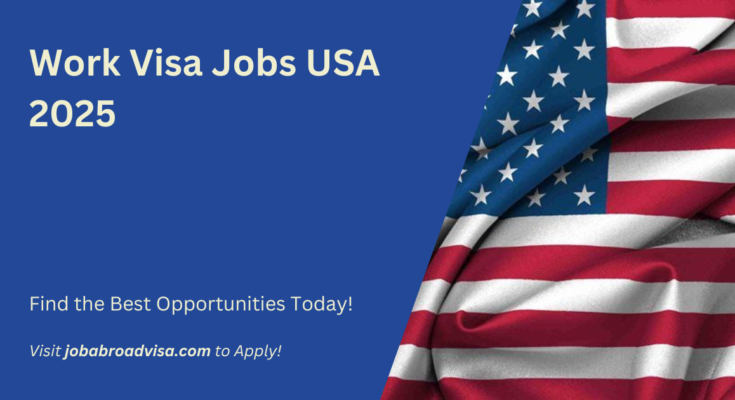Problem: Navigating work visa sponsorship in the USA is complex, competitive, and time-sensitive.
Agitate: Thousands miss opportunities yearly due to unclear processes, scams, or eligibility gaps.
Solution: This guide clarifies 2025’s visa sponsorship pathways, employer trends, and actionable steps for success.
3-Line Answer to the Keyword:
Work visa jobs in the USA for 2025 focus on high-demand sectors like tech, healthcare, and engineering. Employers sponsor visas like H-1B, L-1, or EB-3 for skilled professionals. To qualify, applicants need job offers, proof of expertise, and compliance with updated 2025 immigration policies.
How to Get a Visa Sponsorship Job in the USA (2025 Guide)
Key Takeaway:
Securing visa sponsorship requires targeting the right industries, preparing documentation, and understanding employer expectations.
Step-by-Step Guide to Visa Sponsorship Jobs
- Identify Eligible Employers:
- Use the Department of Labor’s Foreign Labor Certification list.
- Focus on Fortune 500 companies or startups in tech hubs (e.g., Silicon Valley, Austin).
- Tailor Your Application:
- Highlight skills matching the Department of Labor’s Schedule A shortage occupations.
- Include certifications, language fluency, and U.S.-recognized degrees.
- Prepare for the Visa Process:
- Employers file Form I-129 (H-1B) or Form I-140 (EB-3).
- Submit proof of qualifications, job offer letters, and labor condition applications.
Table 1: Top 5 In-Demand Sectors for Visa Sponsorship (2025)
| Sector | Common Roles | Visa Types | Avg. Salary Range |
|---|---|---|---|
| Technology | Software Engineers, Data Analysts | H-1B, O-1 | 90,000–90,000–160,000 |
| Healthcare | Nurses, Physicians | EB-3, H-1B | 70,000–70,000–200,000 |
| Engineering | Civil, Mechanical Engineers | L-1, TN | 80,000–80,000–130,000 |
| Education | Professors, Researchers | J-1, H-1B | 50,000–50,000–120,000 |
| Hospitality | Chefs, Hotel Managers | H-2B, EB-3 | 40,000–40,000–90,000 |
Visa Sponsorship Jobs with Free Accommodation
Key Takeaway:
Some employers offer relocation packages, housing, or stipends to attract global talent.
- Industries Offering Benefits:
- Universities (e.g., research roles with campus housing).
- Oil/Gas companies (remote site roles with lodging).
- Healthcare (rural hospitals providing subsidized housing).
Pro Tip:
Negotiate relocation support during the job offer stage. Use terms like “relocation assistance” in your job search filters.
Common Challenges in 2025 Visa Sponsorship
- Quota Limits: H-1B visas face annual caps (85,000 in 2024; similar expected in 2025).
- Processing Delays: USCIS backlogs may extend wait times by 6–12 months.
- Scams: Fake employers charge fees for “visa guarantees.”
CTA:
“Ready to start your journey? Bookmark the USCIS Visa Bulletin for 2025 updates!”
Work Visa Sponsorship Rules and Compliance (2025 Updates)
Key Takeaway:
Understanding 2025’s updated visa rules ensures compliance and avoids application rejections.
Key Changes in 2025 Visa Policies
- H-1B Lottery Reforms:
- USCIS may prioritize applicants with advanced degrees or higher salary offers.
- Employers must prove “specialty occupation” requirements more rigorously.
- EB-3 Visa Expansion:
- More slots for skilled workers in healthcare and tech due to labor shortages.
- L-1 Visa Stricter Reviews:
- Transferred employees must show 1+ year of employment with the sponsoring company abroad.
Table 2: 2025 Visa Types and Key Requirements
| Visa Type | Purpose | Duration | Employer Obligations |
|---|---|---|---|
| H-1B | Specialty Occupations | 3–6 years | Pay prevailing wage, file LCA |
| L-1 | Intracompany Transfers | 5–7 years | Prove existing employment relationship |
| EB-3 | Skilled/Unskilled Workers | Permanent | Labor certification, PERM approval |
| TN | NAFTA Professionals (Canada/Mexico) | 3 years | Job offer in eligible occupations |
Apply for This Job
Please read the job description carefully while you wait for the apply button to be enabled.
